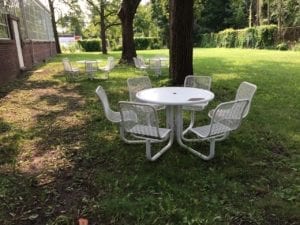Background reading helps a person better understand the larger story, within which local history everywhere is embedded
I’ve recently been reading a book by Aldous Huxley as well as several books about the Second World War. When I read such books, I gain a better understanding of events – local events and world events – connected with the fascinating and engaging history of the Small Arms Inspection Building in Mississauga.
I’ve been following the ongoing repurposing of the latter building for many years.
Stories connected with the building – and the history (and ongoing, community-driven restoration and redevelopment) of the surrounding land extending to the Lake Ontario waterfront – are among the most interesting and inspiring stories that I had the great pleasure of learning about, during the twenty-one years that we lived in Long Branch before we moved away.
The books that I’ve been recently reading, by way of background reading that helps me better understand the larger story, within which local history everywhere is embedded, include (among others):
Genocide: A World History (2017)
An American Genocide: The United States and the California Indian Catastrophe, 1846-1873 (2016)
Fires of Hatred: Ethnic Cleansing in Twentieth-Century Europe (2001)

Jim Tovey and friends at June 17, 2017 Small Arms ceremony. Jaan Pill photo
Beyond Totalitarianism: Stalinism and Nazism Compared (2009)
Past and Present: The challenges of Modernity, from the Pre-Victorians to the Postmodernists (2017)
Ordinary Men: Reserve Police Battalion 101 and the Final Solution in Poland (2017)
The Cut Out Girl: A Story of War and Family, Lost and Found (2018)
Collected Memories: Holocaust History and Postwar Testimony (2003)
Nationalism and modernity
I feel most fortunate to have the opportunity to read such books intensively and in depth. They help me better understand how first-rate historians – and first-rate nonfiction writers everywhere – go about their work. I read library books for several months at a time, after which I forget about such reading and turn to other things.

Jim Tovey speaking at Sept. 24, 2016 “Ground Making” event connected with the Lakeview Waterfront Connection Project.
Photo source: Credit Valley Conservation website
I’ve found it of interest to learn about the applicability – and the drawbacks – of the concept of totalitarianism in relation to the history of Nazi Germany and Stalinist Russia.
As well, I’ve learned some things about the distinction (and the overlap) between ethnic cleansing and genocide. Equally of interest are history-related overviews regarding the documentation and interpretation of events, from the First World War to the 1950s and beyond, in Eastern Europe.
The latter events – I refer in particular to Eastern Europe – have had a strong impact on mindsets, worldviews, and actions affecting people around the world.
The above-noted books offer a person the opportunity to arrive at a systematic understanding of what has occurred in Eastern Europe in the past century and more, and what the consequences of such occurrences have been.
Among other things, the books highlight the close relationship between nationalism and modernity. They also deal with high-level historical decision making and with historical events, lethal and otherwise, involving everyday individuals, families, and communities. Both levels of analysis are important, if we seek to arrive at a well-rounded understanding of history.


Leave a Reply
Want to join the discussion?Feel free to contribute!